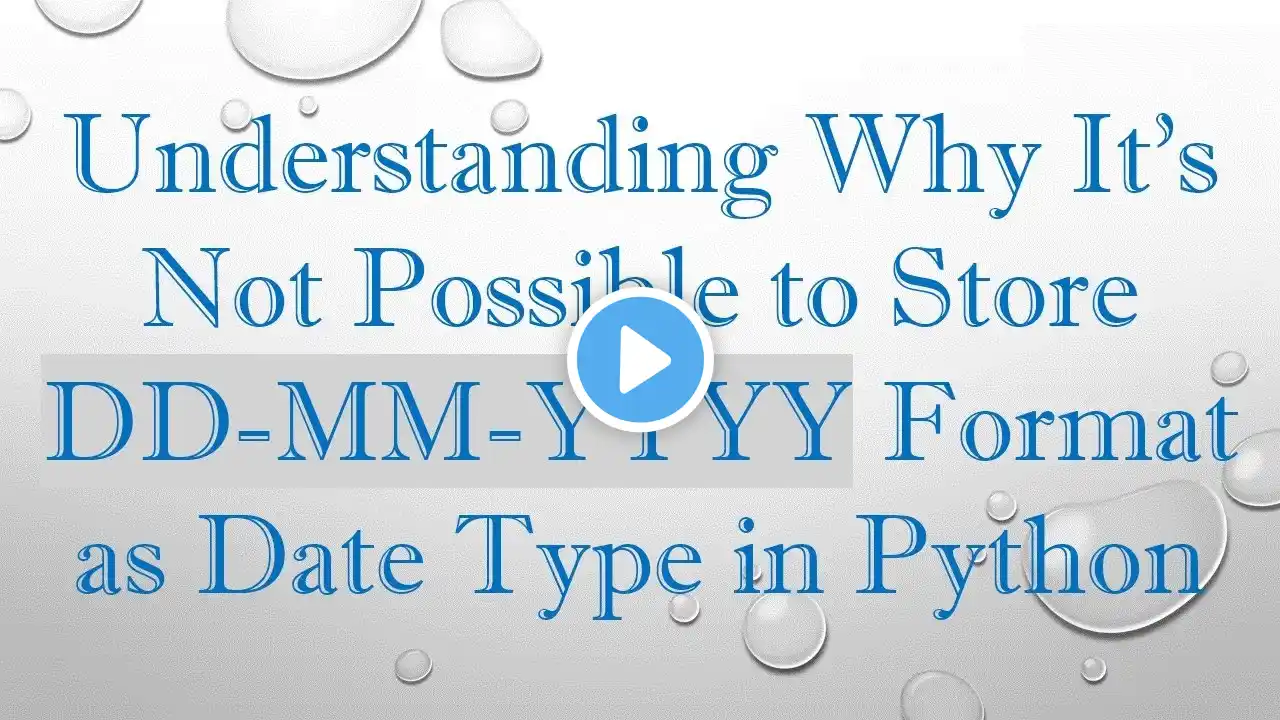
Understanding Why It's Not Possible to Store DD-MM-YYYY Format as Date Type in Python
Learn why storing dates in `DD-MM-YYYY` format is not feasible in Python's date data type and explore efficient solutions for date formatting in pandas. --- This video is based on the question https://stackoverflow.com/q/70665911/ asked by the user 'arodrber' ( https://stackoverflow.com/u/11854775/ ) and on the answer https://stackoverflow.com/a/70666310/ provided by the user 'Cuartero' ( https://stackoverflow.com/u/17901307/ ) at 'Stack Overflow' website. Thanks to these great users and Stackexchange community for their contributions. Visit these links for original content and any more details, such as alternate solutions, latest updates/developments on topic, comments, revision history etc. For example, the original title of the Question was: Why is it not possible to store DD-MM-YYYY format in date format? Also, Content (except music) licensed under CC BY-SA https://meta.stackexchange.com/help/l... The original Question post is licensed under the 'CC BY-SA 4.0' ( https://creativecommons.org/licenses/... ) license, and the original Answer post is licensed under the 'CC BY-SA 4.0' ( https://creativecommons.org/licenses/... ) license. If anything seems off to you, please feel free to write me at vlogize [AT] gmail [DOT] com. --- Why Is It Not Possible to Store DD-MM-YYYY Format in Date Format? When working with dates in Python, especially with the pandas library, you may encounter a situation where you want to convert dates from the YYYY-MM-DD format to the DD-MM-YYYY format. This situation raises an important question: Why can't we store the DD-MM-YYYY format as a date type? In this guide, we will explore the underlying reasons for this limitation and how to approach formatting dates correctly without sacrificing the date type. The Issue with Storing Date Formats In Python, particularly when using libraries like pandas and datetime, the datetime object, which represents dates and times, relies on a consistent internal format for storage. The standard format used by these libraries is YYYY-MM-DD. Here are some key points to understand: Standardization: The YYYY-MM-DD format is recognized as the ISO 8601 format, a widely accepted standard for date interchange. This standardization ensures that date comparisons and arithmetic operations are efficient and straightforward. Data Type Compatibility: The internal representation of dates must allow for operations such as sorting, filtering, and time calculations, which are more complex in a string format like DD-MM-YYYY. When a date is converted to a string format, it loses its date attributes and becomes an object type, which is less efficient for date operations. How to Work with Date Formats in Pandas To achieve the desired DD-MM-YYYY display while retaining the date type for operations, we need to employ specific methods. We’ll discuss a couple of solutions that you can implement in pandas to work with your date data more efficiently. Solution 1: Using Python's datetime Library One straightforward method, albeit not the most efficient, involves using the datetime library to convert the date format. Here’s how you can do it: [[See Video to Reveal this Text or Code Snippet]] Solution 2: Using Pandas' Built-in Methods For better efficiency, you can utilize pandas' vectorized operations. This approach allows you to handle larger datasets more effectively. Here's how you can achieve that: [[See Video to Reveal this Text or Code Snippet]] One-Liner Approach If you prefer efficiency, you can condense the above steps into a single line, which is clean and highly efficient: [[See Video to Reveal this Text or Code Snippet]] Conclusion In conclusion, while storing dates in the DD-MM-YYYY format is not feasible due to compatibility and operational efficiency concerns in Python, you have a variety of methods to convert dates while retaining their functionality for further analysis. By understanding how pandas and Python handle date formats and leveraging the appropriate libraries and functions, you can easily manipulate and display date information in your preferred format without losing the advantages of working with date types. As always, identifying the best method depends on your specific needs in terms of performance and code clarity. With the information provided, you're now well-equipped to handle date formats in Python effectively. Happy coding!